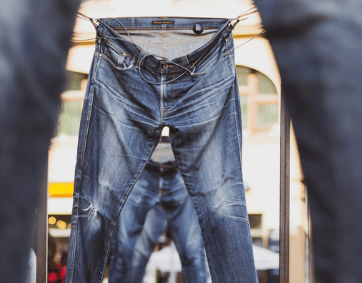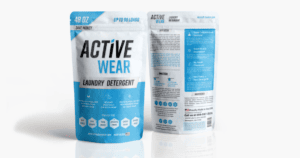How to Get Blood Out of Jeans
-
 By
Sophia Grant
By
Sophia Grant
Denim is a strong and durable material that’s been used for many decades. Traditionally, it’s woven with cotton yarn.
Nowadays, however, it’s often blended with synthetics such as polyester and elastane to prevent shrinkage and add flexibility.
Table of Contents
ToggleHow is Denim Made?
The first step involves gathering the raw materials. Generally speaking, these fibers come from the cotton plant. As for synthetic fibers, they’re typically added during the spinning process—when the fibers are turned into yarn. Once that’s complete, the yarn is dyed to get its color. From there, it’s weaved into fabric.
The Various Styles of Jeans
 There’s more than one type of jeans. Here are some of the most popular styles.
There’s more than one type of jeans. Here are some of the most popular styles.
Straight Leg: This is pretty much the “classic look”. As its name implies, the jeans are straight and narrow—right down to the ankles. Great for any occasion, you can both dress up or dress down, depending on what you pair it with.
Boot Cut: Boot cut jeans are narrow around the thighs and become wider as you move towards the bottom. Not only do they give the appearance of longer legs, but they also give the illusion of a narrow waist. Why are they called what they are? Because they’re compatible with boots—that is, you can wear them without much problem.
Skinny Jeans: Skinny jeans are exactly what they sound like—that is, they offer a slimming look. Close-fitting, they hug your figure all the way down to the ankles. At the same time, they’re comfortable. If anything, they’re one of the best choices for those with a slender figure.
Boyfriend Jeans: Boyfriend jeans are known for their loose fit. More comfortable than skinny jeans, they’re favored by many fashion icons worldwide including Kim Kardashian and Marilyn Monroe.
Different Jean Rises
As it is, there are various jean rise options. Put it simply, it allows you to choose where you want the pair of jeans to sit on your body. In doing so, you can change your perceived waistline.
High Rise: These types of jeans sit above the belly button. They’re a good choice for curvier or shorter women as they can help to elongate the legs.
Mid Rise: Mid-rise jeans are likely the most popular type. Unlike the ones that are high-raise, the waistband sits just below the navel. This can help create a “wider hip look.” Not only that, but it’s also comfortable.
Low-Rise: Low-rise jeans sit below the belly button. For this reason, they’re best worn for casual occasions.
Taking Care of Your Jeans
Jeans, like all clothing, will get dirty. For one thing, mud and dirt can easily get on the fabric—especially if it’s long at the ankles. Sweat is another issue.
Left alone in the laundry hamper, the item can easily start to smell. Considering that, it only makes sense to wash them every now and then.
How to Get Blood Out Of Jeans
 Ever fallen down while wearing a pair of jeans? That can easily lead to an injury and if your blood gets onto the material, that can leave a stain.
Ever fallen down while wearing a pair of jeans? That can easily lead to an injury and if your blood gets onto the material, that can leave a stain.
The same goes for period blood – after all, accidents happen.
Don’t worry, though, it’s possible to remove blood stains from jeans. If anything, you just need to know what to do.
Removing Blood Stains That Are Still Wet
The first thing that you want to do is saturate the blood stain with cold water. You can do this by using an old toothbrush or sponge. Gently scrub the spot to get as much blood out of the material as you can.
Continue until the blood stops coming out of the denim material. From there, you want to rinse the area with water (one of the easiest ways it to put it under running water).
Dissolve a bit of ACTIVE Detergent in warm water in a bowl. Once it’s mixed, saturate your old toothbrush with the mixture and apply it to the blood stain.
The goal is to work it into a lather—that is, there should be bubbles. Continue to scrub with a damp cloth until the stain fades – make sure to be gentle as you don’t want to damage the delicate fabrics.
If necessary, add more detergent. When you’re done, rinse it clean under cold running water.
Once the stain is out, you can launder as normal with a normal wash cycle.
Removing Blood Stains That Are Dry
 Dried blood stains are generally harder to remove compared to “fresh blood.”
Dried blood stains are generally harder to remove compared to “fresh blood.”
First things first, soak the stained fabric in a bucket of cold water. Leave them in there for at least 30 minutes. From there, you can take it out. Do your best to wring out the excess water.
In a small bowl, combine a teaspoon of meat tenderizer with water (the meat tenderizer will help to break down the proteins in the blood stains).
You should end up with a viscous paste. Using your finger or a brush, saturate the dried bloodstain with the mixture. Allow it to sit for another 30 minutes.
Using Baking Soda to Remove Blood Stains
Alternatively, you can use baking soda. Pour a teaspoon of it directly onto the stain and rub it in with a brush. The key is to use small, circular movements. Let it sit for 30 minutes before washing as normal.
Using Hydrogen Peroxide to Remove Blood Stains
Hydrogen peroxide is another option – simply pour it onto the blood stains.
Afterward, cover it with plastic wrap and a towel. That will allow the hydrogen peroxide to soak in better into the fabric. Leave it on for 15 minutes before blotting the blolod stains with a clean towel.
Keep in mind, however, that there’s always a chance that it’ll bleach the fabric. For this reason, you want to test the hydrogen peroxide on an inconspicuous part of the jeans first.
How to Get Musty Smell Out of Jeans
Ever had a pair of jeans smell musty? That’s due to contaminant growth on the fabric. Here’s how you can get rid of that odor once and for all.
If there’s visible residue on your jeans, scrape it off. You can do that with an old toothbrush. Just make sure to be gentle; you don’t want to damage the denim fibers.

Once you’ve done that, put it in the washing machine. For the best results, wash it separately from your other clothes—that way, you won’t have to worry about it possibly contaminating your other items.
Add a scoop of ACTIVE Detergent to the drum and set your washer to a warm setting. You can also add some non-chlorine bleach. Avoid using hot water as that’ll set the stains in further. Let the washing machine run before taking out the jeans and letting them air dry completely. It’s important that you do not dry it in the dryer.
Is the musty odor still present? If so, you’ll want to soak the item. Fill a bucket with warm water and add a scoop of ACTIVE Detergent, mixing until it’s fully dissolved. Place the jeans in, making sure that the stained area is fully submerged in the soapy solution. Allow it to sit for 2-3 hours before placing it back in the washer.
Pro-tip: Consider adding a cup of white vinegar during the rinse cycle. Not only will it remove any unpleasant smell, but it’ll also soften your jeans as well.
What’s more, is that vinegar is capable of neutralizing the contaminants. In doing so, you’ll be able to treat the root of the problem. If necessary, you can also soak it with vinegar first, before running the machine.
Removing Stubborn Blood Stains From Your Jeans – FAQs

Should you use cold water or hot water for blood stains?
Cold water is best when it comes to these stubborn stains. However, you can also use warm water.
Can you remove period stains with liquid laundry detergent?
Yes, you can remove fresh and dried blood stains with liquid laundry detergent. However, we recommend using an enzyme-based formula like ACTIVE Detergent.
Are fresh blood stains easier to remove than dried stains?
Fresh blood is generally easier to remove as it hasn’t set into the fabric yet. For dried blood stains, you may need to use baking soda and another type of stain remover on top of detergent to eliminate the spot.
Can you remove blood stains with dish soap?
Dish soap can be used in a pinch if you don’t have detergent. Add a couple drops onto the blood stain and let it sit for a few minutes. You may also want to do a garment soak before rinsing with cold water.
Can you remove a blood stain with hydrogen peroxide?
Yes, you can soak the stained garment in hydrogen peroxide – it will help remove blood stains. Keep in mind, however, that it can bleach the material.
As you can see, it is possible to remove blood stains from jeans by using the proper methods.
If anything, you just need the right stain remover and in most cases, you can just use laundry detergent, like the one by ACTIVE.
So the next time you get blood stains on your jeans, you’ll know exactly what to do!
15% Off Amazon Coupon
×Click To Reveal The 15% Off Coupon Code For Your Entire ACTIVE Purchase At Amazon.com
Note: This promotional offer is only guaranteed through the end of the day.




